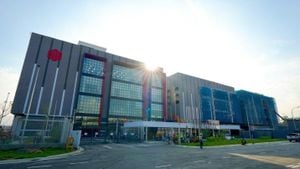Research focusing on the management of apple scab disease has revealed significant resistance trends among populations of Venturia inaequalis, the fungal pathogen responsible for the disease. The systematic study of these trends, which centers on the resistance to two fungicides—difenoconazole and flusilazole—suggests deepening concerns for apple production globally.
The rise of resistance is attributed to the extensive and indiscriminate usage of these triazole fungicides, primarily used to combat the widespread scab disease. The study was launched following alarms raised by researchers over the indiscriminate application of fungicides leading to the emergence of triazole-resistant strains. Collecting isolates from diverse regions within Kashmir, specific attention was directed toward elucidation of resistance mechanisms, their impact on the pathogen's fitness, and the stability of observed resistance traits.
The study emphasized resistance profiling of three separate populations of V. inaequalis sourced from Northern, Southern, and Central Kashmir. Initial assays on protected isolates—never applied with fungicides—displayed varying levels of sensitivity to both chemicals. The mean effective dosage (ED50) values of difenoconazole and flusilazole were determined to be 0.584 µg ml−1 and 0.018 µg ml−1, respectively.
Sequencing analysis identified mutations at codon 133 of the CYP51A1 gene, indicating shifts from TAT (Tyrosine) to TTT (Phenylalanine) among resistant isolates. The researchers stress, though, the complexity of fungicide resistance mechanisms, asserting, "The mutation at codon 133 is not solely responsible for the development of resistance." This nuanced view aligns with the current discourse on how resistance develops gradually through multiple genetic factors rather than rapid changes.
One of the study's most significant revelations is the stability of resistance traits observed across environmental variations, including five consecutive transfers between laboratory growth conditions. Researchers noted no fitness cost associated with the possession of resistance against both fungicides, save for the responses to oxidative stress at 1 mM hydrogen peroxide. This absence of fitness penalties challenges the common expectation of resistant pathogen populations being naturally outcompeted by their sensitive counterparts, which would normally occur when fungicide pressure is reduced.
Researchers pointed out, "Except for oxidative stress at 1 mm H2O2, there is no fitness cost associated with the development of resistance against difenoconazole and flusilazole." Such findings raise alarms over the sustainability of apple production practices using these fungicides, indicating these resistant populations may be entrenched, with reduced likelihood of reverting to sensitive forms even if fungicide usage diminishes.
The conclusions drawn from the findings indicate the urgent need for revised management strategies encompassing sustainable practices aimed at mitigating the risks posed by fungicide resistance. The continuous monitoring of resistance development and detailed analysis of field populations will be pivotal in curbing its spread, urging the collaboration among researchers, farmers, and agricultural managers.
This research significantly progresses the field of mycology and agricultural science, providing insights not only on Venturia inaequalis but also highlighting issues surrounding plant-pathogenic fungi and fungicide resistance globally.
Overall, the investigation encapsulates the pressing environmental and agricultural challenges posed by resistant strains, as well as the necessity for informed practices tailoring to these new dimensions of crop management.



